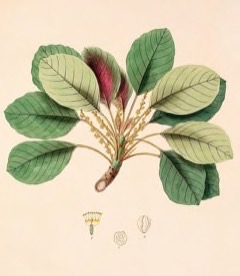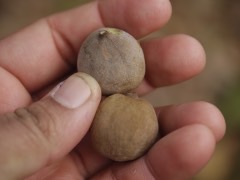 |
|
edibleplants.org |
 |
| Wikimedia.org - Rohit Naniwadekar |
Translate this page:
Summary
Physical Characteristics

 Terminalia bellirica is a deciduous Tree growing to 35 m (114ft) by 35 m (114ft).
Terminalia bellirica is a deciduous Tree growing to 35 m (114ft) by 35 m (114ft).
See above for USDA hardiness. It is hardy to UK zone 10. The flowers are pollinated by Insects.
Suitable for: light (sandy), medium (loamy) and heavy (clay) soils and prefers well-drained soil. Suitable pH: mildly acid, neutral and basic (mildly alkaline) soils and can grow in very acid soils.
It cannot grow in the shade. It prefers dry or moist soil.
UK Hardiness Map
US Hardiness Map
Synonyms
Myrobalanus bellirica Gaertn. Myrobalanus laurinioides Kuntze Terminalia attenuata Edgew. Terminalia moluccana Roxb. Terminalia punctata Roth
Plant Habitats
Edible Uses
Edible Parts: Fruit Seed
Edible Uses:
The seeds are edible[272 , 317 , 451 ]. They are possibly toxic or narcotic[303 , 317 ]. Eating the seeds in any but small quantities can lead to narcotic effects[451 ]. The dark red fruits are edible[46 ]. They can be used for making preserves[301 ]. Subacid, with a pleasant flavour, the smooth-skinned fruit is about 3cm in diameter[46 , 301 ].
References More on Edible Uses
Medicinal Uses
Plants For A Future can not take any responsibility for any adverse effects from the use of plants. Always seek advice from a professional before using a plant medicinally.
The fruit contains anthraquinones and tannins[254 ]. It is anthelmintic, astringent (especially when ripe), digestive, tonic and laxative (especially when unripe)[254 , 272 , 451 ]. The fruit is used internally principally in the treatment of digestive and respiratory problems[254 ]. In Indian herbal medicine the ripe fruit is used in cases of diarrhoea and indigestion, whilst the unripe fruit is used as a laxative in cases of chronic constipation[254 ]. The fruit is often used to treat upper respiratory tract infections that cause symptoms of sore throats, hoarseness and coughs[254 ]. Externally, the fruit is used to make a lotion for sore eyes[46 , 254 ]. The sour fruits are one of the ingredients of 'triphala', an Ayurvedic rejuvenative, laxative tonic based on this species plus the fruits of Phyllanthus emblica and Terminalia chebula[238 ].
References More on Medicinal Uses
The Bookshop: Edible Plant Books
Our Latest books on Perennial Plants For Food Forests and Permaculture Gardens in paperback or digital formats.

Edible Tropical Plants
Food Forest Plants for Hotter Conditions: 250+ Plants For Tropical Food Forests & Permaculture Gardens.
More

Edible Temperate Plants
Plants for Your Food Forest: 500 Plants for Temperate Food Forests & Permaculture Gardens.
More

More Books
PFAF have eight books available in paperback and digital formats. Browse the shop for more information.
Shop Now
Other Uses
The bark is used for making a dye[272 ]. The dried fruits contain 20 - 25% tannin[272 , 303 ]. The fruits yield a dye that is occasionally used together with iron sulphate for dyeing black cloth and matting, as a cheap substitute for indigo, and for preparation of ink[146 , 303 , 317 , 451 ]. The leaves are a source of tannins[46 ]. The seeds yield about 40% of a clear yellow oil, composed of 12% palmitic acid, 16% stearic acid, 43% oleic acid and 29% linoleic acid[303 ]. It is used for hair-oil and in the manufacture of soap[303 , 317 ]. An excellent soap can be prepared using a mixture of 60% of this oil, 25% coconut oil and 15% groundnut oil[303 ]. An insoluble gum is produced in considerable quantity from the trunk[451 ]. The timber is yellowish-grey, lacking heartwood, light to moderately heavy, fairly straight-grained, very coarse-textured. It is not durable, and very prone to insect attack, though durability is said to be improved by immersing the wood in water[303 , 451 ]. It is considered to be of little value[303 ]. It is used for construction and agricultural implements, especially in regions where other timber is scarce or expensive[272 , 303 ]. Large-sized stems are used for dug-out canoes[303 ]. The wood is valued for fuel and for making charcoal[272 , 451 ].
Special Uses
Carbon Farming
References More on Other Uses
Cultivation details
Industrial Crop: Oil Management: Standard Regional Crop
The plant has a wide ecological range, succeeding in tropical and subtropical climates, but does not grow above 600 m altitude[303 ]. It is found at elevations up to 1,400 metres in China[266 ]. In its natural area of distribution mean annual precipitation varies from 1,000 to over 3,000 mm[303 ]. It grows best in areas where annual daytime annual temperatures are within the range 20 - 33°c, though it can tolerate 5 - 45°c[418 ]. It is fairly sensitive to frost, though seedlings can survive, particularly when covered with grass[303 ]. Generally, temperatures of -1°c can kill a tree[418 ]. Succeeds in any moderately fertile, well-drained soil in a sunny position[200 ]. Young trees are somewhat shade tolerant[303 ]. Prefers periodically dry soils, and is moderately drought tolerant[303 , 418 ]. Plants can tolerate short periods of inundation[418 ]. Prefers a pH in the range 5.5 - 6.5, but tolerates 5 - 7.5[418 ]. Trees are leafless for a short period (some weeks) in the dry season[303 ]. Pollination may be done by insects, as the flowers have unpleasant odour, which attracts flies[303 ]. Trees planted at a spacing of 1 metre x 6 metres in Java have a mean annual increment in height of 1.6 metres and diameter of 2.1 cm at the age of 15 years; when sown directly at 1 metre x 3 metres the trees closed their canopy after 5 years and gave an annual height and diameter increment of 1.2 metres and 1.3 cm, respectively, after 6 years[303 ]. The trees had reached a height of 20 - 25 metres in 15 years, after a few thinnings[303 ]. Trees react well to coppicing, but pollarding does not give good results[303 ].
Carbon Farming
-
Industrial Crop: Oil
Materials, chemicals and energy include bioplastics, biomass, glycerin, soaps, lubricants, paints, biodiesel. Oilseed crop types.
-
Management: Standard
Plants grow to their standard height. Harvest fruit, seeds, or other products. Non-Destructive management systems.
-
Regional Crop
These crops have been domesticated and cultivated regionally but have not been adopted elsewhere and are typically not traded globally, Examples in this broad category include perennial cottons and many nuts and staple fruits.
References Carbon Farming Information and Carbon Sequestration Information
Temperature Converter
Type a value in the Celsius field to convert the value to Fahrenheit:
Fahrenheit:
The PFAF Bookshop
Plants For A Future have a number of books available in paperback and digital form. Book titles include Edible Plants, Edible Perennials, Edible Trees,Edible Shrubs, Woodland Gardening, and Temperate Food Forest Plants. Our new book is Food Forest Plants For Hotter Conditions (Tropical and Sub-Tropical).
Shop Now
Plant Propagation
Seed - pre-soaking in cold water for 24 hours prior to sowing has been reported to improve germination rates[303 ]. Buried seeds have a better chance of successful germination[303 ]. The germination rate is quite high for fresh seeds, with reports of 85 - 100% germination, but it declines rapidly when seeds have been stored for some time[303 ]. Germination needs much moisture, and usually takes 2 - 5 weeks[303 ]. Usually sown in a nursery seedbed, the seed can also be sown directly in the field when conditions are favourable[303 ]. When seedlings are raised in the nursery, transplanting to the field before the taproot has developed is strongly preferable, and mostly successful[303 ]. Clipping the roots and shoots checks growth considerably, stumping is not advised[303 ].
Other Names
If available other names are mentioned here
Local Common Names: Bangladesh: bahera. India: akshavriksha; bada; bahada; baheda; bahedo; bahera; baherra; baheruka; baherukka; bahira; balda; balela; balna; balra; barhu; barro; bauri; bayrah; behaza; beheda; behedan; behera; behira; behra; bhaira; bhamora; bharla; bherda; bhotra; birha; boira; bowa; buhura; bulla; bulluch; dubong; goting; hela; hero; kattuelu-pan; kattuelupay; lechara; sag; sagona; santi; silli; tandi; tare; tari; thadi; thandi; thandra; thandri; thani; thara; thare; tharo; vehala; vehela; vela; vibhitaki. Indonesia: jaha; ketapang; sana. Indonesia/Java: jaha kebo; jaha sapi. Indonesia/Sumatra: ulu belu. Laos: heen; nam kieng dam. Malaysia: jelawai; mentalun; simar kulihap. Myanmar: thitsein. Thailand: haen; haen-khao; haen-ton; samo-phiphek. Vietnam: bang hoi; bang moc; nhut.
Native Plant Search
Search over 900 plants ideal for food forests and permaculture gardens. Filter to search native plants to your area. The plants selected are the plants in our book 'Plants For Your Food Forest: 500 Plants for Temperate Food Forests and Permaculture Gardens, as well as plants chosen for our forthcoming related books for Tropical/Hot Wet Climates and Mediterranean/Hot Dry Climates. Native Plant Search
Found In
Countries where the plant has been found are listed here if the information is available
Africa, Asia, Australia, Bangladesh, Bhutan, Cambodia, China, East Africa, Fiji, Hawaii, Himalayas, India, Indochina, Indonesia, Laos, Malaysia, Maldives, Mozambique, Myanmar, Nepal, Northeastern India, Pacific, Pakistan, Philippines, SE Asia, Sikkim, Sri Lanka, Thailand, USA, Vietnam
Weed Potential
Right plant wrong place. We are currently updating this section.
Please note that a plant may be invasive in one area but may not in your area so it’s worth checking.
None Known
Conservation Status
IUCN Red List of Threatened Plants Status : This taxon has not yet been assessed

Growth: S = slow M = medium F = fast. Soil: L = light (sandy) M = medium H = heavy (clay). pH: A = acid N = neutral B = basic (alkaline). Shade: F = full shade S = semi-shade N = no shade. Moisture: D = dry M = Moist We = wet Wa = water.

Expert comment
Author
(Gaertn.) Roxb.
Botanical References
Links / References
For a list of references used on this page please go here
A special thanks to Ken Fern for some of the information used on this page.
Readers comment
| Add a comment |
|
If you have important information about this plant that may help other users please add a comment or link below. Only comments or links that are felt to be directly relevant to a plant will be included. If you think a comment/link or information contained on this page is inaccurate or misleading we would welcome your feedback at [email protected]. If you have questions about a plant please use the Forum on this website as we do not have the resources to answer questions ourselves.
* Please note: the comments by website users are not necessarily those held by PFAF and may give misleading or inaccurate information.
To leave a comment please Register or login here All comments need to be approved so will not appear immediately.
|
Subject : Terminalia bellirica
|
|
|
|